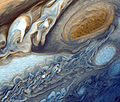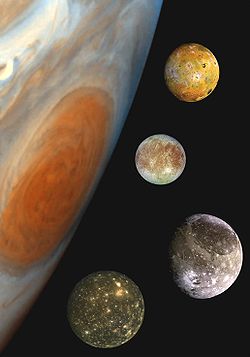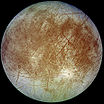
Jupiter in the fiction of Leigh Brackett
Encyclopedia

Jupiter
Jupiter is the fifth planet from the Sun and the largest planet within the Solar System. It is a gas giant with mass one-thousandth that of the Sun but is two and a half times the mass of all the other planets in our Solar System combined. Jupiter is classified as a gas giant along with Saturn,...
, the fifth and largest planet
Planet
A planet is a celestial body orbiting a star or stellar remnant that is massive enough to be rounded by its own gravity, is not massive enough to cause thermonuclear fusion, and has cleared its neighbouring region of planetesimals.The term planet is ancient, with ties to history, science,...
of the Solar System
Solar System
The Solar System consists of the Sun and the astronomical objects gravitationally bound in orbit around it, all of which formed from the collapse of a giant molecular cloud approximately 4.6 billion years ago. The vast majority of the system's mass is in the Sun...
, and its moons
Jupiter's natural satellites
Jupiter has 64 confirmed moons, giving it the largest retinue of moons with "reasonably secure" orbits of any planet in the Solar System. The most massive of them, the four Galilean moons, were discovered in 1610 by Galileo Galilei and were the first objects found to orbit a body that was neither...
play a significant role in the Solar System fiction
Leigh Brackett Solar System
The Leigh Brackett Solar System is a fictional analogue to the real-world Solar System in which a majority of the planetary romances of Leigh Brackett take place....
of Leigh Brackett
Leigh Brackett
Leigh Douglass Brackett was an American author, particularly of science fiction. She was also a screenwriter, known for her work on famous films such as The Big Sleep , Rio Bravo , The Long Goodbye and The Empire Strikes Back .-Life:Leigh Brackett was born and grew up in Los Angeles, California...
. In Brackett's stories, Jupiter's largest moons are inhabited by a variety of exotic intelligent species; the system serves as a frontier region, beyond the explored and settled Triangle worlds of Venus, Earth, and Mars.
As in real life, in Brackett's Solar System Jupiter is a massive, heavy-gravity world swathed in a cloak of poisonous gases, uninhabited as far as anyone knows.
History

For a long time, the human settlements on the Jovian moons were mere colonial outposts, in conflict with the natives of Jupiter's moons and dependent upon the Inner Worlds for supplies. Abortive attempts were made to organize the colonies from an early date, such as the Brotherhood of the Little Worlds (really a criminal enterprise masquerading as a political movement) of Arrod of Callisto (Queen of the Martian Catacombs/The Secret of Sinharat); there were also native uprisings, such as the one led by the Mercurian Eric John Stark
Eric John Stark
Erik John Stark is a character created by science fiction author Leigh Brackett. Stark is the hero of a series of pulp adventures set in a time when the Solar System has been colonized...
(Enchantress of Venus). But it was not until the much later influx of settlers that Jupiter acquired its own identity and nationhood.
This new unity was powerfully expressed in the Jovian war, fought against all of the Triangle Worlds, in which the Jovians had the advantage due to their possession of Jovium, an isotope capable of disintegrating metal (Outpost on Io).
Jupiter obtained control of a considerable number of asteroids (the "Jovian Mandate"), including three of the most water-rich planetoids, as well as a forward base on Ceres. Conflicts over this territory led to a brief war with Venus
Venus in the fiction of Leigh Brackett
Venus and Venusians are frequently appearing settings and characters for many of the Solar System stories of Leigh Brackett. Brackett's Venus shares some characteristics with the astronomical Venus, but in other respects functions as a consistent fantasy world with recurring landmarks and...
(Interplanetary Reporter).
Natural satellites

Natural satellite
A natural satellite or moon is a celestial body that orbits a planet or smaller body, which is called its primary. The two terms are used synonymously for non-artificial satellites of planets, of dwarf planets, and of minor planets....
orbiting it. The four largest of these are Io (Jupiter I), Europa (Jupiter II), Ganymede (Jupiter III), and Callisto (Jupiter IV). They are among the largest moons in the solar system, and only these four are permanently inhabited. Several other moons orbit Jupiter, but none play a significant role in the stories.
Although the diminished heat of the Sun at Jupiter's distance would be expected to leave the moons cold and frozen, Jupiter's gravity causes tidal heating of the three moons' cores, causing internal heating and vulcanism
Volcano
2. Bedrock3. Conduit 4. Base5. Sill6. Dike7. Layers of ash emitted by the volcano8. Flank| 9. Layers of lava emitted by the volcano10. Throat11. Parasitic cone12. Lava flow13. Vent14. Crater15...
.
Io (Jupiter I)

Natural satellite
A natural satellite or moon is a celestial body that orbits a planet or smaller body, which is called its primary. The two terms are used synonymously for non-artificial satellites of planets, of dwarf planets, and of minor planets....
of Jupiter.
Other than a small amount found on Jupiter XI
Carme (moon)
Carme is a retrograde irregular satellite of Jupiter. It was discovered by Seth Barnes Nicholson at Mount Wilson Observatory in California in July 1938. It is named after the mythological Carme, mother by Zeus of Britomartis, a Cretan goddess....
, Io is the only source of Jovium, a radioactive isotope that can trigger a progressive breakdown in metallic atoms. Jovium is extracted from certain blue-green "muds" found on the surface of Io, which also have the property of crystallizing carbon wherever they come into contact with it—including living flesh. It was used as a weapon in the Jovian War, but production of Jovium abruptly halted after the explosive destruction of the Jovians' primary extraction plant.
Due to the instability of its surface, Io is uninhabited by intelligent beings other than military personnel and others involved in mineral extraction. The only significant animal indigenous to Io is the indescribable quag.
Europa (Jupiter II)

Natural satellite
A natural satellite or moon is a celestial body that orbits a planet or smaller body, which is called its primary. The two terms are used synonymously for non-artificial satellites of planets, of dwarf planets, and of minor planets....
of the planet
Planet
A planet is a celestial body orbiting a star or stellar remnant that is massive enough to be rounded by its own gravity, is not massive enough to cause thermonuclear fusion, and has cleared its neighbouring region of planetesimals.The term planet is ancient, with ties to history, science,...
Jupiter
Jupiter
Jupiter is the fifth planet from the Sun and the largest planet within the Solar System. It is a gas giant with mass one-thousandth that of the Sun but is two and a half times the mass of all the other planets in our Solar System combined. Jupiter is classified as a gas giant along with Saturn,...
. It is the fourth largest by diameter
Diameter
In geometry, a diameter of a circle is any straight line segment that passes through the center of the circle and whose endpoints are on the circle. The diameters are the longest chords of the circle...
and mass
Mass
Mass can be defined as a quantitive measure of the resistance an object has to change in its velocity.In physics, mass commonly refers to any of the following three properties of matter, which have been shown experimentally to be equivalent:...
of Jupiter's satellites. It is the smallest of the four Galilean moons.
Europa is home to a number of species, including two intelligent ones, the Europan birdmen and the tentacled Europans.
- The tentacled Europans stand approximately eight feet tall. They move about on four "rubbery" legs, which support a body with smooth black skin. Their tentacles are manipulative and sensory appendages that sprout in a crown from the top of their body. Being extremely strong, they are often used as soldiers, though they have a propensity to motion sickness (Outpost on Io).
- The Europan birdmen are basically humanoid, but with small, wiry bodies and wings spanning twenty feet. They are light enough to be capable of flight both on Europa and on Earth (The Halfling).
Ganymede (Jupiter III)
Ganymede is Jupiter's largest moonNatural satellite
A natural satellite or moon is a celestial body that orbits a planet or smaller body, which is called its primary. The two terms are used synonymously for non-artificial satellites of planets, of dwarf planets, and of minor planets....
, and indeed the largest moon in the entire solar system
Solar System
The Solar System consists of the Sun and the astronomical objects gravitationally bound in orbit around it, all of which formed from the collapse of a giant molecular cloud approximately 4.6 billion years ago. The vast majority of the system's mass is in the Sun...
; it is larger in diameter than Mercury
Mercury in the fiction of Leigh Brackett
right|250px|MercuryThe planet Mercury appears frequently as a setting for many of the stories of Leigh Brackett, and Mercury and Mercurians are frequently mentioned in other stories of the Leigh Brackett Solar System...
but only about half its mass.
Ganymede is one of Jovian moons most hospitable to life. Its internal heat raises its temperature higher than would be expected from solar radiation, while interactions between its ocean, volcano
Volcano
2. Bedrock3. Conduit 4. Base5. Sill6. Dike7. Layers of ash emitted by the volcano8. Flank| 9. Layers of lava emitted by the volcano10. Throat11. Parasitic cone12. Lava flow13. Vent14. Crater15...
es and biosphere have produced an oxygen-rich atmosphere, though one that also has a high sulfur content.
Callisto (Jupiter IV)

Natural satellite
A natural satellite or moon is a celestial body that orbits a planet or smaller body, which is called its primary. The two terms are used synonymously for non-artificial satellites of planets, of dwarf planets, and of minor planets....
of the planet
Planet
A planet is a celestial body orbiting a star or stellar remnant that is massive enough to be rounded by its own gravity, is not massive enough to cause thermonuclear fusion, and has cleared its neighbouring region of planetesimals.The term planet is ancient, with ties to history, science,...
Jupiter. It is the third-largest moon in the solar system
Leigh Brackett Solar System
The Leigh Brackett Solar System is a fictional analogue to the real-world Solar System in which a majority of the planetary romances of Leigh Brackett take place....
, and the second largest satellite of Jupiter, about the same size as the planet Mercury
Mercury in the fiction of Leigh Brackett
right|250px|MercuryThe planet Mercury appears frequently as a setting for many of the stories of Leigh Brackett, and Mercury and Mercurians are frequently mentioned in other stories of the Leigh Brackett Solar System...
.
Callisto possesses two quite distinct intelligent species. One type is humanoid, though smaller and thinner than humans, and with four arms. These Callistans have scarlet eyes, white fur, and scarlet feather-like antennae atop their heads. They possess psionic abilities that they can project through the music of specially designed instruments (The Citadel of Lost Ships).
The other intelligent species, the cat-men, descend from a feline ancestor. In shape they closely resemble humans, and except for their tails, clawed feet, and a mane of fur across their shoulders and down their backs to the tail could pass for human. They are, however, forbidden to mix with humans and will retaliate against any member of their species who does so. Their most significant weakness is the propensity to become addicted to coffee (The Halfling).
Stories set in the Jovian system
- Outpost on Io (Planet StoriesPlanet StoriesPlanet Stories was an American pulp science fiction magazine, published by Fiction House between 1939 and 1955. It featured interplanetary adventures, both in space and on other planets, and was initially focused on a young readership. Malcolm Reiss was editor or editor-in-chief for all of its 71...
November/Winter 1942) - The Dancing Girl of Ganymede (novelette; Thrilling Wonder Stories February 1950)
Other stories
- Interplanetary Reporter (Startling StoriesStartling StoriesStartling Stories was an American pulp science fiction magazine, published from 1939 to 1955 by Standard Magazines. It was initially edited by Mort Weisinger, who was also the editor of Thrilling Wonder Stories, Standard's other science fiction title. Startling ran a lead novel in every issue;...
May 1941) - Cube from Space (Super Science StoriesSuper Science StoriesSuper Science Stories was an American pulp science fiction magazine published by Popular Publications from 1940 and 1943, and again from 1949 to 1951. Popular launched it under their "Fictioneers" imprint, which they used for magazines paying writers less than one cent per word...
August 1942) - The Halfling (novelette; Astonishing StoriesAstonishing StoriesAstonishing Stories was an American pulp science fiction magazine, published by Popular Publications between 1940 and 1943. It was founded under Popular's "Fictioneers" imprint, which paid lower rates than Popular's other magazines. The magazine's first editor was Frederik Pohl, who also edited a...
February 1943) - The Citadel of Lost Ships (Planet StoriesPlanet StoriesPlanet Stories was an American pulp science fiction magazine, published by Fiction House between 1939 and 1955. It featured interplanetary adventures, both in space and on other planets, and was initially focused on a young readership. Malcolm Reiss was editor or editor-in-chief for all of its 71...
March 1943) - Shadow Over Mars (Startling StoriesStartling StoriesStartling Stories was an American pulp science fiction magazine, published from 1939 to 1955 by Standard Magazines. It was initially edited by Mort Weisinger, who was also the editor of Thrilling Wonder Stories, Standard's other science fiction title. Startling ran a lead novel in every issue;...
Fall 1944) published in book form as The Nemesis from Terra - The Veil of Astellar (novelette; Thrilling Wonder Stories Spring 1944)
- Queen of the Martian Catacombs (Planet StoriesPlanet StoriesPlanet Stories was an American pulp science fiction magazine, published by Fiction House between 1939 and 1955. It featured interplanetary adventures, both in space and on other planets, and was initially focused on a young readership. Malcolm Reiss was editor or editor-in-chief for all of its 71...
Summer 1949) published in book form as The Secret of Sinharat - City of the Lost Ones (novella; Planet StoriesPlanet StoriesPlanet Stories was an American pulp science fiction magazine, published by Fiction House between 1939 and 1955. It featured interplanetary adventures, both in space and on other planets, and was initially focused on a young readership. Malcolm Reiss was editor or editor-in-chief for all of its 71...
Fall 1949) also published as Enchantress of Venus

